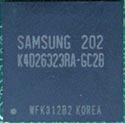Since the Ti4600 is built on the same 0.15 micron
technology that build the GeForce3, the 63 million transistor die is large
and runs hot. Apparently nVidia realized that they could brand not only the
Geforce 4 name, but also the type of heatsink used to cool it down. The heatsink
they chose is now as recognizable as the chip
underneath it.
MSI use a modified variation of this heatsink and
other then a few cosmetic differences, it is the same heatsink found on the Gainward GeForce 4
PowerPack GS Ultra/750XP and
half a dozen other cards.
MSI have put a thin piece transparent plastic over the fins on
the heatsink to duct the air. The plastic forces the air to flow though
the fins and onto the BGA memory which improves cooling efficiency.
This type of cooling solution does generate quite a bit of noise
compared to other GPU coolers. While it doesn't bother me, it does produce
a higher pitch which may annoy some people. Upon removing the heatsink to check
on the core, we were glad to see that MSI used a good
amount of thermal paste between the GPU and heatsink - you would be
surprised how many manufacturers skip this crucial step with their products!
 With the memory naked we see that the
MSI G4Ti4600-VTD uses Samsung BGA RAM which has a 2.8 ns rating
and is clocked at 660 MHz.
With the memory naked we see that the
MSI G4Ti4600-VTD uses Samsung BGA RAM which has a 2.8 ns rating
and is clocked at 660 MHz.
If you do the math 1000 / 2.8 (ns) x 2 (DDR)=714 MHz so that means the memory
has been certified to run up to 714 MHz. Assuming all the voltages are correct and
heat isn't an issue, we should be able to clock the memory
up to at least 714 MHz!
One thing you'll notice here is that MSI clocks the
memory 10 MHz higher then other Ti4600's. This doesn't really affect performance since
the clock differences are too small.
If you'd like to learn a little more on GeForce 4 technology
please read our Gainward GeForce 4 PowerPack GS Ultra/750XP or nVidia GeForce 4
preview.
Overclocking:
The core of the MSI G4Ti4600-VTD we tested is based on the
A2 stepping so I knew (raises right hand and shakes it wildly) that
overclocking would be met with limited success. Still, we were pleasantly
surprised to see the nVidia core go up to 325 MHz with just air cooling,
and the memory to 770 MHz! The memory did get quite hot during
testing, but interestingly there were no artifacts on the screen. It's a
good thing.
If you want to get an idea what kind of
results you can get with an overclocked GeForce4 Ti4600 and a Thermoelectric
device cooled by an Alpha and 7000RPM Delta have a look at this article on
FrostyTech.com.
